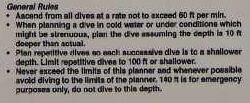the other day we did some reef cleaning like we do a lot here to get the fishing nets of the reef. the reef is about 30mt deep. so time flys, and the dive is very close to the ndl, try not to get into deco on these dive's  What i'm wondering is most tables are made for recreational diving and when you do serious exercise or work your body pumps more oxygen to the muscle so more nitrogen too? then when you are on the way up you are no longer working so the blood flow to the muscles is less making is harder to off gas. how would you calculate dive time and ndl for a dive where one was physically active. there is always the possibility( as we mostly do) of doing the 5mt safety stop on nitrox 50 and doing it for 5min or more but that's all just adding safety. how would one Calculate
What i'm wondering is most tables are made for recreational diving and when you do serious exercise or work your body pumps more oxygen to the muscle so more nitrogen too? then when you are on the way up you are no longer working so the blood flow to the muscles is less making is harder to off gas. how would you calculate dive time and ndl for a dive where one was physically active. there is always the possibility( as we mostly do) of doing the 5mt safety stop on nitrox 50 and doing it for 5min or more but that's all just adding safety. how would one Calculate  thanks
thanks
then a P.S. if this hard work was done on a mix of lets say nitrox 32 would there be higher risk of cns toxicity as the body is absorbing more oxygen ?
then a P.S. if this hard work was done on a mix of lets say nitrox 32 would there be higher risk of cns toxicity as the body is absorbing more oxygen ?







